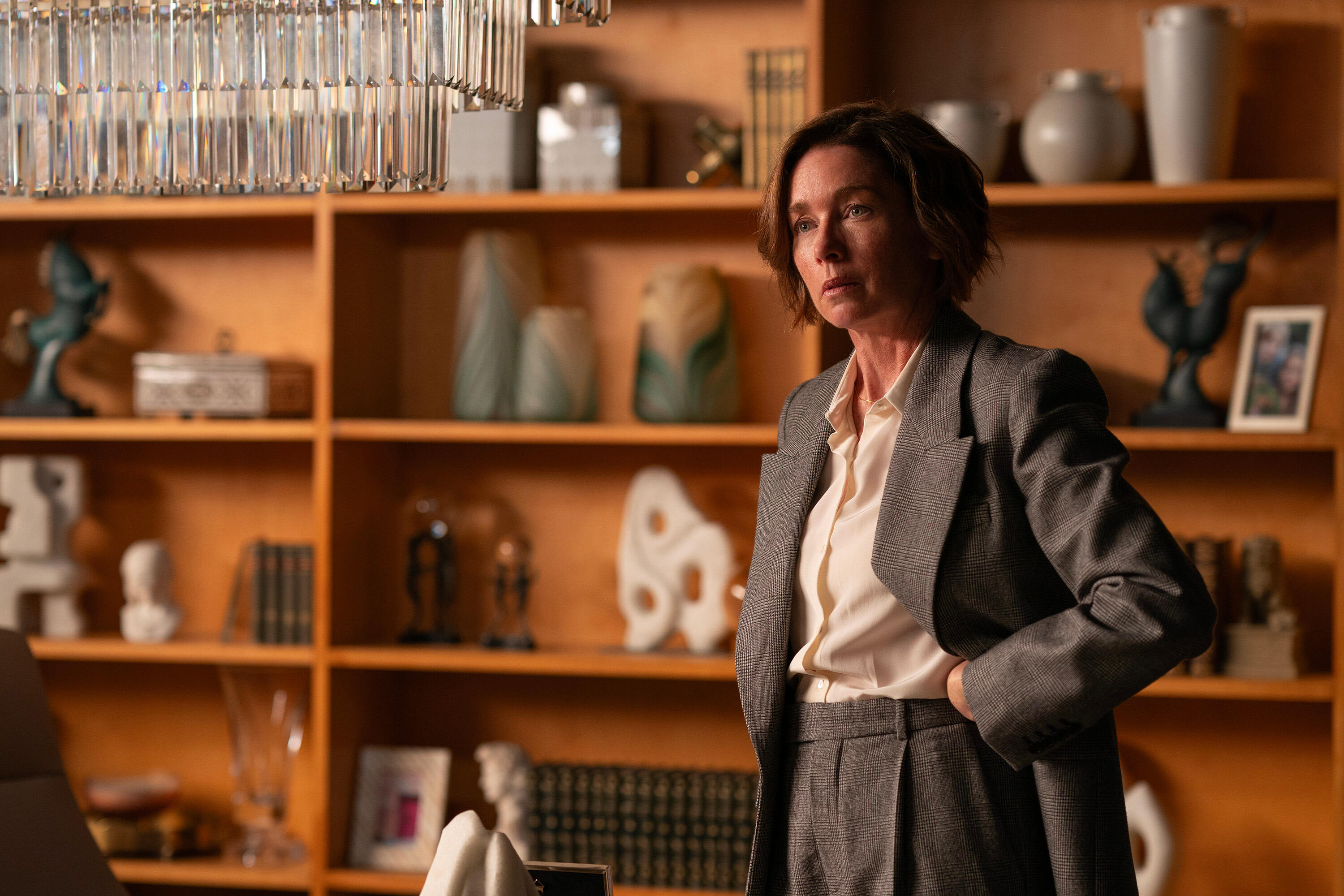Twenty years ago, writer-producer Ronald D. Moore refused to give a crowd of angry, disappointed sci-fi nerds what they wanted.
This was Galacticon in Los Angeles, a convention organized by actor Richard Hatch to celebrate the 25th anniversary of Battlestar Galactica’s maiden broadcast. Hatch had spent the past eight years rallying fans of the 1978 space opera in which he’d played the daring Colonial warrior Apollo, hoping to convince Universal that the property was ripe for revival. And Hatch wasn’t fooling around — according to So Say We All: The Complete, Uncensored, Unauthorized Oral History of Battlestar Galactica by Mark A. Altman and Edward Gross, Hatch spent $50,000 out of pocket to finance and direct a proof-of-concept short film called Battlestar Galactica: The Second Coming. It was essentially a pilot for a sequel series in which he and a few other actors from the original would reprise their roles alongside a new generation of characters. The Second Coming was exactly the sort of “legacy sequel” that would become popular years later in the 2010s, and the fans were fully behind it, with many even donating their own costumes, props, and visual effects expertise to the project. A trailer was screened at conventions in 1999, to what Hatch described as standing ovations.
What Moore screened for fans at Galacticon in October 2003 got a considerably cooler reception. (“Polite, but hostile,” as Kate O’Hare described it in the LA Times.) Moore had come with five minutes of footage from the totally reimagined Battlestar Galactica miniseries that was due to premiere on cable that December. The audience knew better than to get their hopes up, and so did Moore — he and co-producer David Eick’s script for the miniseries leaked before shooting had even begun, and fans had been voicing their displeasure ever since. Moore and Eick’s Battlestar Galactica bore little resemblance to the sincere and pulpy 1978 original. This was a grimy, naturalistic military science fiction show with a lot of blood, sex, and murky politics. It discarded the established continuity and, most unforgivable of all, it recast Galactica’s roguish pilot Starbuck as a woman. So far as most of the assembled fans were concerned, this wasn’t Battlestar Galactica.
:no_upscale()/cdn.vox-cdn.com/uploads/chorus_asset/file/25139062/112354238.jpg)
After screening the footage — which was met with boos — Moore took increasingly heated questions from fans, one of whom asked, point-blank, whether he would take their criticisms into consideration if the miniseries was a success and the new Battlestar was ordered to series. Moore answered, “No.” He and his team had their own vision for the show, their own story they wanted to tell, and the fans could either take it or leave it.
Twenty years later, Moore and Eick’s Battlestar Galactica has totally eclipsed the original. Though mostly ignored by the Emmys (this was before they paid attention to genre shows), BSG was a critical darling that garnered mainstream attention, a Peabody Award, and an invitation for its stars and creators to address the United Nations. It still ranks among one of the greatest TV shows of all time.
In short, the fans were wrong, and if Moore had bowed to their demands, we’d all have missed out on something special.
Such a thing feels as though it could never happen in today’s pop culture ecosystem. This isn’t to say that Hollywood studios weren’t foolish or cowardly in the early 2000s, an era in which every recognizable property was being remade or rebooted. They did, at least, demonstrate a desire to try new things with the recognizable brands they were exploiting. Audiences expected remakes to justify themselves by putting some sort of spin on the source material, and the remakes that had their own identity — like Zack Snyder’s Dawn of the Dead, J.J. Abrams’ Star Trek, or, hell, Steven Soderbergh’s Ocean’s Eleven — are the ones that have held up. Christopher Nolan’s Dark Knight trilogy and the Daniel Craig Bond films were products of this environment, new interpretations of well-trod characters that attracted new audiences, even at the risk of alienating fans of the old versions.
:no_upscale()/cdn.vox-cdn.com/uploads/chorus_asset/file/15980713/Casino_Royale_Three_Piece.jpg)
:no_upscale()/cdn.vox-cdn.com/uploads/chorus_asset/file/11697403/heaths_joker_300x128.jpg.jpg)
Risks like these were possible in part because, unlike today, franchises were allowed to die, or at least to go into hibernation for extended periods. Moore’s Battlestar Galactica was the first meaningful installment in the series in over 20 years. Both Batman Begins and Casino Royale were produced years after their respective franchises had burned out with Batman & Robin and Die Another Day, respectively. Contrary to the modern trend, there was great incentive not to pick up where the previous entries had left off. If a decade went by without a new sequel in a film series, that series was presumed to be over, and attempts to reopen a saga that had concluded on a high note, such as Indiana Jones and the Kingdom of the Crystal Skull, were seen as a novelty to be greeted with some skepticism. Since the revival of a nostalgic brand was not considered a given, audiences who might have been reluctant to accept a new take might at least give it a shot on the grounds that it was “better than nothing,” and perhaps be pleasantly surprised.
Moreover, even uninterrupted continuities were expected to be accessible to new viewers, as there was no infrastructure by which mass audiences could easily get caught up on lengthy or complicated mythologies. Before the advent of DVD box sets, DVR, and video on demand, it wasn’t even assumed that viewers had seen every episode of a show they were watching, never mind the show or shows from which it had spun off. Many fandoms had well-maintained online hubs for brushing up on the history or production of their favorite franchises, but there was no Wikipedia — never mind individual Wikipedia pages for every show on television — and there was no movie explainer content mill.
Fandom itself has changed radically since the birth of social media, as have studios’ relationships with it. While some Hollywood storytellers have been interacting with fans on the internet since the days of UseNet and AOL groups — including Moore himself during the run of Star Trek: Deep Space Nine — fans have far greater access to the people who make their favorite media, and these interactions now take place in venues with much higher traffic. It’s not just the die-hards huddling together on forums to converse, develop opinions, and promote agendas for other die-hards. Posts pop off, hashtags trend, and thinkpieces go viral to the feeds of more casual fans — or just as importantly, to non-fans whose only impression of the work in question comes from fan discourse. YouTube, TikTok, and Patreon have made it possible, even lucrative, to be a full-time fan of something, and these influencers create enough content to keep fans engaged constantly, between official releases. It’s never been easier, or more mainstream, to pick a brand you like and make it your entire personality, and studios now consider these fandoms to be, effectively, an unpaid arm of their marketing department. In 2003, the online obsessives and the angry convention guests were not assumed to represent the majority of the audience. Now, these fans are the audience, as well as part of the product. In the unimaginably vast sea of content, you’re getting nowhere without their breath in your sails.
:no_upscale()/cdn.vox-cdn.com/uploads/chorus_asset/file/24904345/bsg306_1264.jpg)
This feeds back into why properties aren’t permitted to rest long enough for there to be demand for a new take. If the content slows down, so does fan engagement, and without an active fandom, who’s going to produce the groundswell of online excitement around the next iteration when it does arrive? If it’s different, who’s to say they’ll like it? It’s a safer bet to keep the engine turning, even if what it’s producing isn’t exciting or approachable enough to attract anyone new. Keeping the fans you have happy becomes everything, and blandness ensues.
The 2003 Battlestar Galactica miniseries, and the ongoing series that debuted the following year, never played it safe; in fact, its storytellers seemed to delight in their audience’s discomfort. Despite its origins as a remake of a nostalgic 1970s romp whose iconography was emblazoned on lunchboxes, Ron Moore and David Eick did not treat their show like a “sci-fi property.” It was a drama, aiming more for viewers who did not, as a rule, watch “geek stuff” than for those who did. Protecting the brand or creating a perpetual profit machine was not a priority, and when they did extend the franchise with a spinoff, it was with an even less conventional series, the family drama Caprica. Caprica may not have found a sustainable audience, but it was an attempt at converting interest in a cosmic war epic into interest in something totally different, rather than simply more of the same.
Naturally, Universal began developing yet another new version of Battlestar Galactica in 2009, before Moore’s series had even wrapped its final season, in an effort to keep the brand hot. When now-disgraced director Bryan Singer was attached to direct, the new BSG movie was teased to somehow “exist between” the classic and reimagined versions, a strategy that certainly feels apiece with modern IP management. The project has been in development hell now for over a decade, bouncing back and forth between creatives and the big and small screens, with no word of progress since 2020. I’m grateful for this. With any luck, by the time cameras roll on a new Battlestar Galactica movie or series, it will have been 20 years since the show I love came to an end, and there will be an actual appetite for its rebirth. And, if we’re really lucky, whoever’s in charge of it will have their own vision and stick to it, whether I like it or not.







